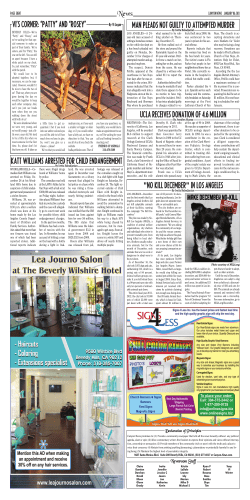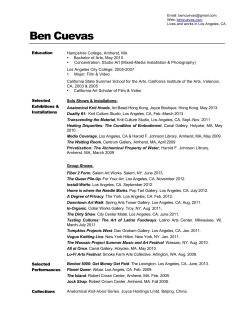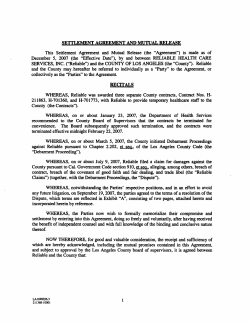
What kind of questions can we ask of data and how to
What kind of questions can we ask of data and how to answer them Dr. Hulya Farinas @emirfarinas © Copyright 2013 2014 Pivotal. All rights reserved. 1 The Quantified Patient Medical History Genetics Family History Imaging Clinical Narratives Medications Molecular Diagnostics Lab tests Environment © Copyright 2014 Pivotal. All rights reserved. Sensors & Mobile 2 Integrative patient phenotype Medical history © Copyright 2014 Pivotal. All rights reserved. Genetics Imaging Clinical narratives Labs 3 Targeting for Breast Cancer Treatment Getting the whole picture improves predictive power True positive rate • More data from different sources • Provides a more complete view • Improves statistics and inference Medical History False positive rate Medical History Clinician Notes Medical History Clinician Notes Genetics Medical History Clinician Notes Genetics Imaging Is more data always better? ICD-9-CM 428.0 Congestive Heart Failure Can we trust this diagnosis? Demographics • 25 year old • Female Lab Orders • no Complete Blood Count • no electrolytes (NA, K, Mg) • no Serum Creatinine • no Blood Urea Nitrogen Patient Medical History • No known history of cardiovascular diseases • No known respiratory illnesses Medications Given • no anticoagulants • no antiplatelet agents • no beta blockers • no diuretics • no statins Having access to multiple sources of data allow us to interrogate and clean the data, employ smart imputation methods when data completeness is an issue © Copyright 2014 Pivotal. All rights reserved. 5 What questions to ask ? Clinical Decision Support Resource Allocation Patient Behavior Operations Diagnosis with patient history, medical images, gene expression etc. Risk stratification based on predicted health care spend Identify usage patterns i.e. ER Frequent Flyers Physician Benchmarking Comparative effectiveness research Risk stratification for mortality and hospital readmissions Adherence to medication, exercise regiment Mining charts for reporting compliance Mining biomedical literature Risk stratification for hospital acquired infections Behavioral Risk Assessment for Surgical Outcome Revenue Assurance: Claims processing Mining EHR to drive current visit outcomes Predict Emergency Wait Times Alert for known adverse events and discover new ones Predict Disease Prevalence/Outbreaks Fraud Detection with Accounts Payable Identifying Gaps in Care/ Proactive Care © Copyright 2014 Pivotal. All rights reserved. 6 APPS PEOPLE Where to start* ? Hospital Admins Hospital Staffing Scheduling DATA MODEL Discharge Nurses/PA Gaps in Care Surface Relevant Literature Coordinate Care Healthcare Cost Readmission Length of Stay Encounter Procedures Lab Results *Not a comprehensive list Mortality Diagnoses Medication Chronic Disease Mgmt Therapy Recommender Adverse Events Differential Diagnosis Risk Assessment EDIP Bed History Monitor Feeds Engagement Comparative Effectiveness Personalized Medicine Biomedical Lit. Matching Orders Patients Surface Relevant EMR Compliance Hospital Census Bed Mgmt Physicians Medical Images Clinician Notes Sequence Data Intervention Design Pharmacovigilance Telemetry Literature Environment Self Reporting Data Molecular Diagnosis How to solve these problems? 1. Acquire the Right Technology © Copyright 2014 Pivotal. All rights reserved. 2. Hire Data Scientists 3. Establish the Path for Operationalization 8 Step 1 - Acquire the Right Technology REQUIREMENTS Able to deal with structured and unstructured data sources Scalable Anticipate all the questions we may ask to data one day Computation needs to be closer to data Vendor should have data science services that can help with technology adoption © Copyright 2014 Pivotal. All rights reserved. Data Modeler 9 Technology Adoption Journey of a Major Healthcare Provider Prove that better technology can speed up discovery Prove that better technology can improve model quality •Length of Stay Modeling Prove that technology is accessible to my clinicians and researchers Prove that data science can help in areas other than clinical analytics Prove that, once trained, our scientists can get to insights as quickly as the Pivotal DS team •Fraud Detection for Accounts Payable •EDIP Modeling in 4 days •Comorbidity Feature Generation App • Code-a-thon © Copyright 2014 Pivotal. All rights reserved. 10 Step 2 - Hire Data Scientists (or Teach New Tricks to Your Data Analysts/Scientists) Data analysts approach at a provider is typically hypothesis driven Problem Definition Interview Clinicians for Potential Features Interview Data Owners to Locate Data Try Out Different Model Forms Try Out Different Model Forms Validate Findings with Experts Data Driven Approach Problem Definition Build Hundreds of Features © Copyright 2014 Pivotal. All rights reserved. 11 Problem Statement Motivation – Excessive LOS are estimated to be 5-6% of hospital budgets – Knowing when a patient would be ready for discharge allows better resource allocation decisions Business Objective – Predict the length of stay conditioned on things that are known at the time of admission Scope – Patients whose admission diagnosis is AMI © Copyright 2014 Pivotal. All rights reserved. Level 1 LOS Modeling: Conditioned on Patient Demog, Medical History, Hospital Characteristics, Admission Type/Source/Time Level 2 LOS Modeling + Admission Diagnosis Level 3 LOS + Monitor Feeds Procedures data collected during hospitalizations 12 Framework for LOS Modeling Level 1 LOS Modeling: Conditioned on Patient Demog, Medical History, Hospital Characteristics, Admission Type/Source/Time Classifier for Discharge Type Classifier LOS>120 hrs Conditional LOS By Hour Ensemble Model Level 2 LOS Modeling + Admission Diagnosis Class Probabilities Conditional LOS Prediction Linear Model Level 3 LOS + Monitor Feeds Procedures data collected during hospitalizations © Copyright 2014 Pivotal. All rights reserved. Final Prediction 13 Model Fit LOS<=120 Cond. LOS by Hour Predicted probability of transfer Classification Actual discharge=transfer © Copyright 2014 Pivotal. All rights reserved. 14 Sample insights from the modeling Admissions By Hour Variance Explained When Category Excluded Discharge By Hour Current Admission Lab Med. History Demog Hospital LOS for AMI has Markov property like qualities: Recent observations are more predictive than patient medical history © Copyright 2014 Pivotal. All rights reserved. LOS is not only biology. It is also operations! Admission Time, Day of Week, hospital’s size and experience with cardiology matter. 15 Step 3 - Operationalization • 83,767* articles on sepsis • 9,644* articles on readmissions • 362,710* articles on drug-drug interaction • 560,442* articles on cancer treatment When we visit our doctors we should all expect to benefit from the latest discoveries without requiring our physician to be a superhero. Dissemination of insights is as important as extracting the insight from data. Based on NCBI PubMed search in April 2014 © Copyright 2014 Pivotal. All rights reserved. 16 Rules of Operationalization Understand – – – – Target user groups Their attitudes towards data science What decisions they make When they make these decisions As much as possible integrate analytics into users workflow seamlessly Iterate!!! – Living models – Living/evolving applications © Copyright 2014 Pivotal. All rights reserved. 17 What Matters: Apps. Data. Analytics. Apps power businesses, and those apps generate data Analytic insights from that data drive new app functionality, which in-turn drives new data The faster you can move around that cycle, the faster you learn, innovate & pull away from the competition © Copyright 2014 Pivotal. All rights reserved. 18 BUILT FOR THE SPEED OF BUSINESS
© Copyright 2025















